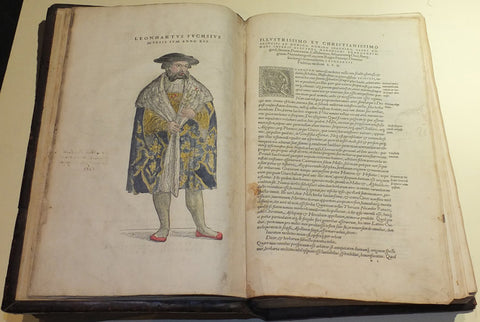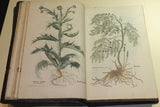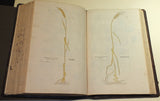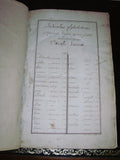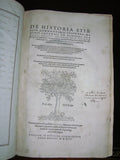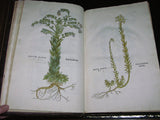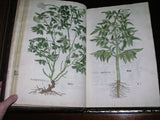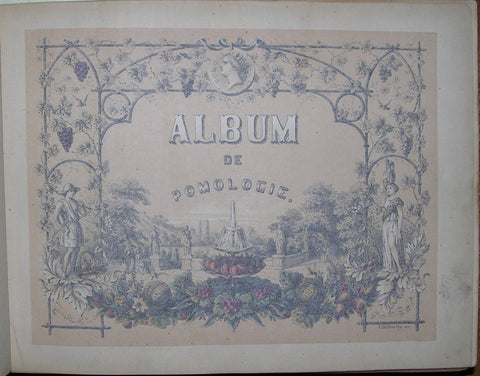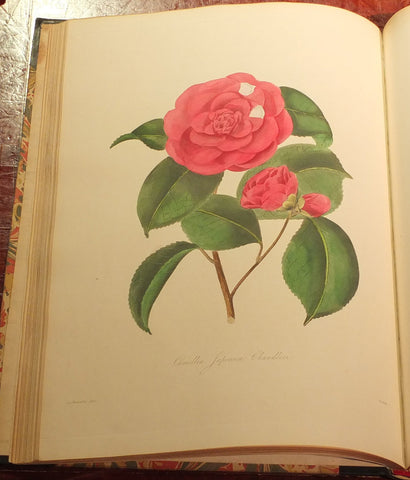Leonhard Fuchs (1501-1566), De historia stirpium commentarii insignes...
Leonhard Fuchs (1501-1566)
De historia stirpium commentarii insignes. adiectis earundem vivis plusquam quingentis imaginibus, nunquam antea ad naturae imitationem artificiosius effectis & expressis.
Basel: Michel Isingrin, 1542
Folio (14 4/8 x 10 4/8 inches). Roman type, preface in italic, index and German plant names in gothic type. Full-page woodcut of the author "at the age of 41" on verso of title-page, 509 full-page botanical woodcuts, two smaller woodcuts in the text, by Veit Rudolphe Speckle after Heinrich Füllmaurer and Albrecht Meyer, and three woodcut self-portraits of the artists on recto of errata leaf (penultimate leaf, fff5). Woodcut printer's device on title and verso of final leaf; woodcut historiated initials (title-leaf and last 2 leaves rehinged, preliminary text leaf a4 apparently supplied, foremargins of last few leaves affected by damp and repaired, the repair to last leaf grazing the edge of woodcut on recto, repaired 2-inch tear to f. mm6 just touching woodcut, 5 or 6 leaves with small marginal tears not affecting text or image, ff. I3.4 with fore-edges frayed or chewed, small stain in lower gutters of first 50 leaves). Supplemental 18th-century manuscript indices bound in at front and back, on guards.
Binding: Contemporary blind-paneled German calf over wooden boards, each cover decorated with two panels of bird and floral roll-tool and blind fillets, remains of two brass corner pieces, fore-edge lettered "Fux" at top and "Legendre" in later 18th-century double-line capitals (skillfully rebacked to style, endpapers renewed).
Provenance: "Legendre", early fore-edge lettering; ownership inscription of Lambert Michel Winckelmann dated 1714 on the title-page, and a few marginal notes; manuscript indices and marginalia of Jean Baptiste Lestiboudois (1715-1804), botanist, pharmacist, and author; a few Linnean names added in pencil in a modern hand; Fr. Redmond Ambrose Burke, historian of reading and publishing.
"The most celebrated and beautiful herbal ever published" (Printing and the Mind of Man).
First edition. An exceptionally tall and internally fresh copy with original hand coloring throughout, complementing the stunning botanical impressions. Verso of plates reflects the early coloring with some oxidation of green pigment, typical and highly desirable for work of this age.
RARE WITH COMPLETE COLORING
Another hugely important German botanical work also richly illustrated and with full colored wood cuts, recently sold at Christie’s Sale 12139, Valuable Books and Manuscripts, on July 13th, 2016 for GBP 1,930,500, though it had a significant ownership history.
Fuchs was a part of revolutionizing the art of botanical illustration with his rigorously accurate depictions of plants, as an alternative to re-copying the traditional woodblocks and schematic illustrations of previous editions of herbals. Fuchs' work describes and illustrates over 400 German plants and 100 foreign plants and includes the first illustrations of approximately forty plants, amongst them several newly discovered American species such as maize and pumpkin. This international focus reflects the growing trend in Europe to look outward, and Fuchs was in keeping with recent discoveries made by Explorers and Adventurers. Truly a revolutionary work that set Fuchs apart from accomplished, but limited botanicals such as Brunfels' "Herbarum vivae icons" of 1530. As with his predecessors Fuchs based much of his text on the traditional works of Dioscorides, but his work is complimented by new observations based on practical experience.
In their turn Fuchs's woodcuts became models, not only for the many later editions of this work, but for the works of other botanical writers, including Bock, Dodoens, and William Turner. From the distinguished libraries of generations of scholars: Michel Winckelmann signed the title-page in 1714, and identified himself as a pharmacist from Lille, he has added a few marginal notes, including several lengthy ones on the medicinal properties and pharmaceutical preparation of some of the plants. Jean-Baptiste Lestiboudois from Douai was pharmacist to the French army before settling in Lille, where he became a reknowned botanist, founding the Lille botanical garden, writing an early appreciation of the nutritional and agricultural benefits of the potato, and other important botanical publications including an innovative botanical table (1774) that brought together the classification systems of Linnaeus and J. P. Tournefort. Lestiboudois has added the correct Linnean names in manuscript below the Latin captions to each woodcut, crossing out any incorrect nomenclature, and supplied a 16-page manuscript index to the Linnean names of each plant, neatly written in double column within ruled frames (signed on the first page "J.J.B.Lestiboudois"), and and 8 1/4 page classified index of the plants arranged according to Linnaeus' sexual system. Fr. Redmond Ambrose Burke (whose collection of important early printed books was sold at Sotheby's in 1997) was the author of a short history of the index: "What is the Index?", Milwaukee 1952, among other studies in the history of publishing and reading. Adams F-1009; Blunt, pp. 48-56; Nissen BBI 658; Fairfax Murray German 175; Grolier/Horblit 33b; Hunt I, 48; Durling 1675; Pritzel 3138; Stafleu TL-2 1909.
We Also Recommend

